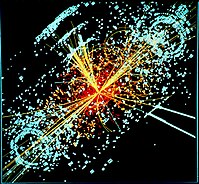
Photo from wikipedia
Recently, it has been argued that application of the Weak Gravity Conjecture (WGC) to spin-2 fields implies a universal upper bound on the cutoff of the effective theory for a… Click to show full abstract
Recently, it has been argued that application of the Weak Gravity Conjecture (WGC) to spin-2 fields implies a universal upper bound on the cutoff of the effective theory for a single spin-2 field. We point out here that these arguments are largely spurious, because of the absence of states carrying spin-2 Stuckelberg $U(1)$ charge, and because of incorrect scaling assumptions. Known examples such as Kaluza-Klein theory that respect the usual WGC do so because of the existence of a genuine $U(1)$ field under which states are charged, as in the case of the Stuckelberg formulation of spin-1 theories, for which there is an unambiguously defined $U(1)$ charge. Theories of bigravity naturally satisfy a naive formulation of the WGC, $M_W< M_{\rm Pl}$, since the force of the massless graviton is always weaker than the massive spin-2 modes. It also follows that theories of massive gravity trivially satisfies this form of the WGC. We also point out that the identification of a massive spin-2 state in a truncated higher derivative theory, such as Einstein-Weyl-squared or its supergravity extension, bears no relationship with massive spin-2 states in the UV completion, contrary to previous statements in the literature. We also discuss the conjecture from a swampland perspective and show how the emergence of a universal upper bound on the cutoff relies on strong assumptions on the scale of the couplings between the spin-2 and other fields, an assumption which is known to be violated in explicit examples.
Journal Title: Physical Review D
Year Published: 2019
Link to full text (if available)
Share on Social Media: Sign Up to like & get
recommendations!